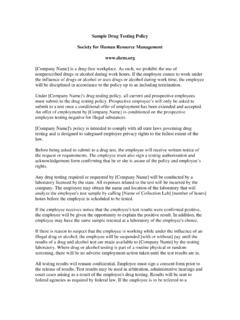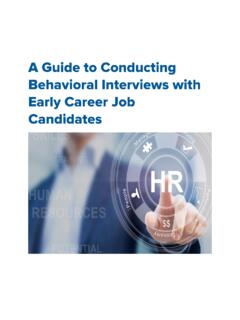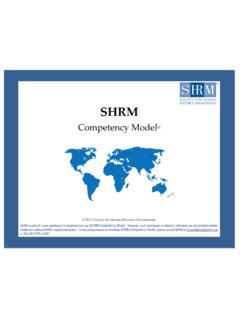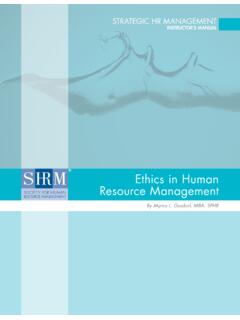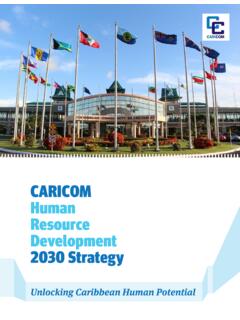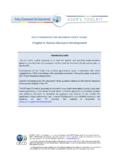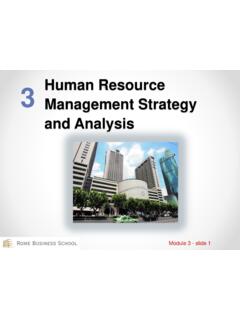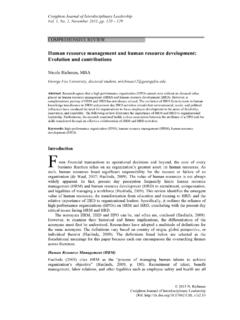Transcription of 21st-Century Human Resource Management Strategic
1 21st-Century Human Resource Management Strategic Planning and Legal IssuesPartIStrategy-Driven Human Resource Management 2 The New Human Resource Management Process1 The Legal Environment and Diversity Management3 The New Human Resource Management Process1 Learning Outcomes After studying this chapter you should be able Identify the difference between the traditional view of Human Resource Management and the 21st-Century view Describe the major HRM skill Discuss the line manager s HRM Identify and briefly describe the major HRM discipline Explain the Practitioner s Model for HRM and how it applies to this Define the following terms: Human resources Employee engagementCost center Revenue centerProductivity center Productivity Effectiveness Efficiency Job satisfaction Turnover AbsenteeismSustainable competitive advantage Information Age Knowledge worker Technical skills Human relations skills Conceptual and design skills Business skills Line managerStaff manager society for Human Resource Management (SHRM) Chapter 1 Outline Why Study Human Resource Management ?
2 HRM Past and PresentPast View of HRM Present View of HRM21st-Century HRM HRM ChallengesThe HRM Strategic ViewTechnology and KnowledgeLabor DemographicsProductivity and Competitiveness Through HRMHRM Skills Technical SkillsHuman Relations SkillsConceptual and Design SkillsBusiness SkillsLine Managers HRM ResponsibilitiesLine Versus Staff Management Major HR Responsibilities of Line ManagementHR Managers Responsibilities: Disciplines Within HRM The Legal Environment: EEO and Diversity ManagementStaffingTraining and DevelopmentEmployee RelationsLabor and Industrial RelationsCompensation and BenefitsSafety and SecurityEthics and SustainabilityHRM Careers The society for Human Resource ManagementOther HR OrganizationsProfessional LiabilityThe Practitioner s Model for HRMThe Model Sections of the ModelTrends and Issues in HRM Technology and High-Performance Work SystemsIncreasing GlobalizationEthical Issues Reverse DiscriminationA.
3 Employee and Labor Relations (required)4. Employee engagement5. Employee involvement6. Employee retention20. AttendanceB. Employment Law (required)22. Professional liabilityD. Organization Development (required)5. Improving organizational effectiveness6. Knowledge management9. Ongoing performance and productivity initiatives10. Organizational effectivenessH. Strategic HR (required)6. Internal consulting (secondary)9. Ethics (integrated)11. Organizational effectivenessCase 1-1. Welcome to the World of 21st-Century HRMSHRMHR CONTENTSee Appendix A: SHRM 2010 Curriculum Guidebook for the complete list 4 PART I: 21st-Century Human Resource Management Strategic PLANNING AND LEGAL ISSUESHRM Is a Profession!In my personal opinion, the increase in employer require-ments for professional certification exemplifies the transi-tion in Human Resource Management from record keeper to Strategic partner status.
4 I m glad I was encouraged to certify as soon as possible. The investment in certification paid off in tangible proof of expertise in the body of knowl-edge deemed essential for work in Human Resources, and helped me advance my employment opportunities. Actually, my professional progress was set in motion with membership in professional HR organizations. First I became a society for Human Resource Manage-ment (SHRM) student member, which provided access to SHRM s website valuable for research while I was a col-lege student, and still an often used Resource in my work. Next, my involvement spread to the local HR association. The chapter meetings provide excellent opportunities to network, swap best practice policies, and learn from colleagues.
5 It was here that I discovered the HR Certifica-tion Institute training classes. I am still good friends with many of the people I met during those classes. In fact, the people who invest in certification are the ones who tend to become more involved in their profession and, by exten-sion, to become more successful as well. I, Cindy Wright, invite you to join me throughout this text-book as we explore real-life HR situations highlighting important information from each chapter. Continue read-ing Chapter 1 to discover more about Human Resource Management as a v vCindy came late to the Human Resources profession, and perhaps that explains some of her passion for the field. As she explains: It s not often that one is lucky enough to be able to decide as an adult exactly what it is you really want to do and then go out and do it.
6 Bringing her background experience as an involved parent, community volunteer, and fam-ily business manager to bear on her education, Wright graduated summa cum laude with a Business Administration degree, HR emphasis. Cindy tested for her Human Resource Certification Institute (HRCI) Certifica-tion as a Professional in Human Resources (PHR) at her initial date of eligibility because she believes certification is a crucial element of s first position as a benefits specialist for a Caterpillar dealer with 500 employees allowed her to conduct the com-pany s first ever employee benefit satisfaction survey and revamp a paid time off arrangement for the hourly workers as a result. After further employment as a benefits administrator for seven thousand telecommunication s retirees, she has shifted to an HR Generalist position with Saxon Drilling, a gas well drilling company employing just under 500 membership in the profession s national organization the society for Human Resource Management (SHRM), Wright has been active in the local affiliated chapter the Central Arkansas Human Resources Association (CAHRA).
7 Wright serves as Vice President of Administration for the chap-ter s Board as well as Chair of the College Relation s Commit-tee. She was recognized by her peers with the Rising Star award for her work in creating a student chapter membership. Currently involved in organizing a CAHRA satellite chapter in Conway, AR, Wright s mission is to provide assistance to oth-ers interested in entering into and advancing within the Human Resources STUDY Human Resource Management ?It s natural at this point to be thinking, What can I get from this book? or What s in it for me? These questions are seldom asked or answered directly. But they should be Success in our professional and personal lives is about creating relationships,2 and students understand the importance of So the short answer is that the better you can work with people and this is what most of this book is about the more successful you will be in your personal and professional lives as an employee, a manager, or a Human Resource Manager.
8 Today s students want courses to have practical So that is the focus of this book; we designed it to be the most relevant how to book you ever used. As indicated by its subtitle, Functions, Applications, and Skill Development, this book uses a three-pronged approach, with these objectives: Chapter 1: The New Human Resource Management Process 5 To teach you the important functions and concepts of Human Resource Manage-ment (HRM) To develop your ability to apply the HRM functions and concepts through critical thinking To develop your HRM skills in your personal and professional livesThe book offers some unique features to further each of these three objectives, as sum-marized in Exhibit s go on to the longer answer to why we study HRM.
9 Human Resource issues are emerging as some of the most prominent concerns for owners and You ve prob-ably heard buzzwords floating around about managers and particularly Human Resource Managers needing to be more Strategic , business focused, customer focused, and generally in tune with the overall operational success of the Think about it for a minute. What is happening in today s business environment that might be causing Human Resource Managers to rethink their way of doing business? One of the primary items that is causing this process of rethinking Management is that there is much greater competition within most industries today compared to 20 or 30 years As a result, Human Resource Managers as well as Operational Managers have been forced to think in more Strategic terms about how their organization can win against their competitors by utilizing their Human One simple fact is that, in the 21st-Century organization, Human resources the people within an organization are one of the primary means of creating a competitive advantage for the organization, because Management of Human resources affects Why is this?
10 It s simply because most organizations of comparable size and scope within the same industry generally have access to the same material and facilities-based resources. This being the case, it s very difficult to create a competitive advantage based on material, facility, or other tangible or economic resources. What this leaves is people. If the organization can manage its people ( Human resources) more successfully than its competitors can, if it can get employees involved in the day-to-day success of the organization, it has a much greater chance of being successful with the term successful defined as being more productive and more profitable than the competition. Managers are responsible for getting the job done through employees,10 so the organization s Human resources are its most valuable (As you can see, there is a SHRM Guide box next to this section.)










